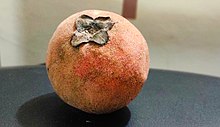| Velvet apple | |
|---|---|

| |
| A velvet apple | |
| Scientific classification | |
| Kingdom: | Plantae |
| Clade: | Tracheophytes |
| Clade: | Angiosperms |
| Clade: | Eudicots |
| Clade: | Asterids |
| Order: | Ericales |
| Family: | Ebenaceae |
| Genus: | Diospyros |
| Species: | D. blancoi |
| Binomial name | |
| Diospyros blancoi A.DC. | |
| Synonyms | |
| |
Diospyros blancoi, (synonym Diospyros discolor), commonly known as velvet apple, velvet persimmon, kamagong, or mabolo tree, is a tree of the genus Diospyros of ebony trees and persimmons. It produces edible fruit with a fine, velvety, reddish-brown fur-like covering. The fruit has a soft, creamy, pink flesh, with a taste and aroma comparable to peaches.
It is widely distributed and native to the Philippines, but it is also native to eastern and southern Taiwan. It has also been introduced to other parts of Southeast Asia, the Pacific Islands, South Asia, the Caribbean, Florida, and other tropical regions.
Cultivation
It is a dioecious tropical tree that grows well in a diversity of soil, from sea level to 750 metres (2,400 ft) above sea level. Seed trees are normally planted 10–15 metres (30–45 ft) from each other; this one can be planted from 7.5–9 metres (25–30 ft) from each other. It needs a good distribution of rainfall through the year. Trees that were planted by seeds could take 6 or 7 years to give out fruit, but trees that were propagated by cuttings produce fruit in 3 or 4 years. It is a very productive tree.
The fact that fruits vary greatly – in shape, color, hairiness and taste – suggests that there is a great deal of genetic variation in the plant. Seedless cultivars exist, and are highly favored since in the normal varieties the large seeds occupy a considerable volume of the fruit.
-
 Velvet apple (Diospyros discolor)
Velvet apple (Diospyros discolor)
-
 Velvet apple (sliced)
Velvet apple (sliced)
-
 Velvet apple (Diospyros discolor) seeds
Velvet apple (Diospyros discolor) seeds
-
 Mabolo fruit
Mabolo fruit
Timber

Like that of other trees in Dyospiros, which includes ebony, Kamagong timber is extremely dense and hard and is famous for its dark color.
The wood is generally used for house construction which include flooring, post, doors, and windows, among others. Finished products from kamagong wood, such as fine furniture and decoratives can be exported, provided that they are properly documented and approved by the Customs authorities. Kamagong is also popular for martial arts training implements such as bokken and eskrima sticks.
Secondary metabolites
The leaves of velvet apple trees have been shown to contain isoarborinol methyl ether (also called cylindrin) and fatty esters of α- and β-amyrin. Both isoarborinol methyl ether and the amyrin mixture demonstrated antimicrobial activity against Escherichia coli, Pseudomonas aeruginosa, Candida albicans, Staphylococcus aureus and Trichophyton mentagrophytes. Anti-inflammatory and analgesic properties have also been shown for the isolated amyrin mixture.
Governance
It is an endangered tree species and protected by Philippine law – it is illegal to export kamagong timber from the country without special permission from the Bureau of Forestry, Department of Environment and Natural Resources.
See also
References
- ^ "Diospyros blancoi". Germplasm Resources Information Network. Agricultural Research Service, United States Department of Agriculture. Retrieved 20 Nov 2016.
- Hargreaves, Dorothy; Hargreaves, Bob (1970). Tropical Trees of the Pacific. Kailua, Hawaii: Hargreaves. p. 29.
- Boning, Charles R. (2006). Florida's Best Fruiting Plants: Native and Exotic Trees, Shrubs, and Vines. Sarasota, Florida: Pineapple Press, Inc. p. 135. ISBN 1561643726.
- Hung, Sheng-Feng; Roan, Su-Feng; Chang, Tsu-Liang; King, Hen-Biau; Chen, Iou-Zen (January 2016). "Analysis of aroma compounds and nutrient contents of mabolo (Diospyros blancoi A. DC.), an ethnobotanical fruit of Austronesian Taiwan". Journal of Food and Drug Analysis. 24 (1): 83–89. doi:10.1016/j.jfda.2015.08.004. PMC 9345435. PMID 28911412.
- Morton, Julia F. (1987). Fruits of Warm Climates. Creative Resources Systems. ISBN 9780961018412.
- Traditional and Emerging Species for Furniture and Handicraft Industries (PDF). ERDB, College, Laguna, Philippines: Ecosystems Research and Development Bureau. 2010. p. 31. ISBN 978-971-8831-28-1. Archived from the original (PDF) on 4 February 2021. Retrieved 4 February 2021.
- Maningas, Rad (8 Apr 2015). Balintawak: Lessons in Eskrima. iUniverse. ISBN 978-1-4917-4997-5. Retrieved 4 February 2021.
- ^ Ragasa, CY; Puno, MR; Sengson, JMA; Shen, CC; Rideout, JA; Raga, DD (November 2009). "Bioactive triterpenes from Diospyros blancoi". Natural Product Research. 23 (13): 1252–1258. doi:10.1080/14786410902951054. PMID 19731144. S2CID 205836127.
External links
 Media related to Diospyros discolor at Wikimedia Commons
Media related to Diospyros discolor at Wikimedia Commons Data related to Diospyros discolor at Wikispecies
Data related to Diospyros discolor at Wikispecies
| Taxon identifiers | |
|---|---|
| Diospyros blancoi |
|
| Diospyros discolor | |